Site Selection of Hybrid Offshore Wind and Wave Energy Systems in Greece Incorporating Environmental Impact Assessment
Abstract
1. Introduction
2. Calculation of EPV
3. Methodology
3.1. Study Area
3.2. HOWiWaES Concept for Deployment
3.3. Methodological Framework for Identifing the Most Adeqaute Site
3.4. Tools and Techniques Used in the AHP
4. Results and Discussion
4.1. Priority Vector of Evaluation Criteria
4.2. Relative Weights of Siting Alternatives
4.3. Hierarchy Ranking of Siting Alternatives
5. Conclusions
Author Contributions
Funding
Conflicts of Interest
References
- Pineda, I.; Tardieu, P. (Eds.) Wind in Power 2017. Annual Combined Onshore and Offshore Wind Energy Statistics. 2018. Available online: https://windeurope.org/wp-content/uploads/files/about-wind/statistics/WindEurope-Annual-Statistics-2017.pdf (accessed on 28 June 2018).
- Pineda, I. (Ed.) Offshore Wind in Europe—Key Trends and Statistics 2017. 2018. Available online: https://windeurope.org/wp-content/uploads/files/about-wind/statistics/WindEurope-Annual-Offshore-Statistics-2017.pdf (accessed on 24 July 2018).
- Atcheson, M.; Garrad, A. Looking back. In Floating Offshore Wind Energy: The Next Generation of Wind Energy, 1st ed.; Cruz, J., Atcheson, M., Eds.; Springer International Publishing: Basel, Switzerland, 2016; pp. 1–2. ISBN 978-3-319-29396-7. [Google Scholar]
- Magagna, D.; Uihlein, A. Ocean energy development in Europe: Current status and future perspectives. Int. J. Mar. Energy 2015, 11, 84–104. [Google Scholar] [CrossRef]
- Antonio, F.D.O. Wave energy utilization: A review of the technologies. Renew. Sustain. Energy Rev. 2010, 14, 899–918. [Google Scholar] [CrossRef]
- Malara, G.; Arena, F. Analytical modelling of an U-oscillating water column and performance in random waves. Renew. Energy 2013, 60, 116–126. [Google Scholar] [CrossRef]
- Elhanafi, A.; Macfarlane, G.; Fleming, A.; Leong, Z. Experimental and numerical investigations on the hydrodynamic performance of a floating–moored oscillating water column wave energy converter. Appl. Energy 2017, 205, 369–390. [Google Scholar] [CrossRef]
- Elhanafi, A.; Macfarlane, G.; Fleming, A.; Leong, Z. Experimental and numerical measurements of wave forces on a 3D offshore stationary OWC wave energy converter. Ocean Eng. 2017, 144, 98–117. [Google Scholar] [CrossRef]
- Zhang, X.; Yang, J. Power capture performance of an oscillating-body WEC with nonlinear snap through PTO systems in irregular waves. Appl. Ocean Res. 2015, 52, 261–273. [Google Scholar] [CrossRef]
- Sergiienko, N.Y.; Rafiee, A.; Cazzolato, B.S.; Ding, B.; Arjomandi, M. Feasibility study of the three-tether axisymmetric wave energy converter. Ocean Eng. 2018, 150, 221–233. [Google Scholar] [CrossRef]
- Michailides, C. Power production of the novel WLC wave energy converter in deep and intermediate water depths. Recent Patents Eng. 2015, 9, 42–51. [Google Scholar] [CrossRef]
- Zhang, X.; Lu, D.; Guo, F.; Gao, Y.; Sun, Y. The maximum wave energy conversion by two interconnected floaters: Effects of structural flexibility. Appl. Ocean Res. 2018, 71, 34–47. [Google Scholar] [CrossRef]
- Buccino, M.; Vicinanza, D.; Salerno, D.; Banfi, D.; Calabrese, M. Nature and magnitude of wave loadings at Seawave Slot-cone Generators. Ocean Eng. 2015, 95, 34–58. [Google Scholar] [CrossRef]
- Contestabile, P.; Iuppa, C.; Di Lauro, E.; Cavallaro, L.; Andersen, T.L.; Vicinanza, D. Wave loadings acting on innovative rubble mound breakwater for overtopping wave energy conversion. Coast. Eng. 2017, 122, 60–74. [Google Scholar] [CrossRef]
- Han, Z.; Liu, Z.; Shi, H. Numerical study on overtopping performance of a multi-level breakwater for wave energy conversion. Ocean Eng. 2018, 150, 94–101. [Google Scholar] [CrossRef]
- Martins, J.C.; Goulart, M.M.; Gomes, M.D.N.; Souza, J.A.; Rocha, L.A.O.; Isoldi, L.A.; dos Santos, E.D. Geometric evaluation of the main operational principle of an overtopping wave energy converter by means of Constructal Design. Renew. Energy 2018, 118, 727–741. [Google Scholar] [CrossRef]
- Exo, K.M.; Huppop, O.; Garthe, S. Birds and offshore wind farms: A hot topic in marine ecology. Bulletin 2003, 100, 50–53. [Google Scholar]
- Drewitt, A.L.; Langston, R.H.W. Assessing the impacts of wind farms on birds. Ibis 2006, 148, 29–42. [Google Scholar] [CrossRef]
- Koschinski, S.; Culik, B.M.; Henriksen, O.D.; Tregenza, N.; Ellis, G.; Jansen, C.; Kathe, C. Behavioral reactions of free-ranging porpoises and seals to the noise of a simulated 2 MW wind power generator. Mar. Ecol. Prog. Ser. 2003, 265, 263–273. [Google Scholar] [CrossRef]
- Wahlberg, M.; Westerberg, H. Hearing in fish and their reactions to sounds from offshore wind farms. Mar. Ecol. Prog. Ser. 2005, 288, 295–309. [Google Scholar] [CrossRef]
- Thomsen, F.; Lüdemann, K.; Kafemann, R.; Piper, W. Effects of Offshore Wind Farm Noise on Marine Mammals and Fish, Biola. Hamburg, Germany on Behalf of COWRIE Ltd. Available online: https://www.researchgate.net/publication/228653581_Effects_of_Offshore_Wind_Farm_Noise_on_Marine_Mammals_and_Fish (accessed on 8 January 2018).
- Öhman, M.C.; Sigray, P.; Westerberg, H. Offshore Windmills and the Effects of Electromagnetic Fields on Fish. Ambio 2007, 36, 630–633. [Google Scholar] [CrossRef]
- Gill, A.B. Offshore renewable energy: Ecological implications of generating electricity in the coastal zone. J. Appl. Ecol. 2005, 205, 605–615. [Google Scholar] [CrossRef]
- Petersen, J.K.; Malm, T. Offshore windmill farms: Threats to, or possibilities for, the marine environment. Ambio 2006, 35, 75–80. [Google Scholar] [CrossRef]
- Wilhelmsson, D.; Malm, T.; Thompson, R.; Tchou, J.; Sarantakos, G.; McCormick, N.; Luitjens, S.; Gullström, M.; Patterson Edwards, J.K.; Amir, O.; et al. (Eds.) Greening Blue Energy: Identifying and Managing the Biodiversity Risks and Opportunities of Off Shore Renewable Energy; IUCN: Gland, Switzerland, 2010; 102p, Available online: https://www.actu-environnement.com/media/pdf/news-22257-etude-uicn.pdf (accessed on 8 January 2018).
- Fayram, A.H.; de Risi, A. The potential compatibility of offshore wind power and fisheries: An example using bluefin tuna in the Adriatic Sea. Ocean Coast Manag. 2007, 50, 597–605. [Google Scholar] [CrossRef]
- Langhamer, O. Artificial Reef Effect in relation to Offshore Renewable Energy Conversion: State of the Art. Sci. World J. 2012, 2012, 386713. [Google Scholar] [CrossRef] [PubMed]
- Kaldellis, J.K.; Apostolou, D.; Kapsali, M.; Kondili, E. Environmental and social footprint of offshore wind energy. Comparison with onshore counterpart. Renew. Energy 2016, 92, 543–556. [Google Scholar] [CrossRef]
- Wilson, B.; Batty, R.S.; Daunt, F.; Carter, C. Collision Risks between Marine Renewable Energy Devices and Mammals, Fish and Diving Birds; Report to the Scottish Executive; Scottish Association for Marine Science: Oban, UK, 2007; Available online: https://depts.washington.edu/nnmrec/workshop/docs/Wilson_Collisions_report_final_12_03_07.pdf (accessed on 8 January 2018).
- Inger, R.; Attrill, M.; Bearhop, S.; Broderick, A.C.; Grecian, W.J.; Hodgson, D.J.; Mills, C.; Sheehan, E.; Votier, S.C.; Witt, M.J.; et al. Marine renewable energy: Potential benefits to biodiversity? An urgent call for research. J. Appl. Ecol. 2009, 46, 1145–1153. [Google Scholar] [CrossRef]
- Woolf, D.K. Environment, Regulation and Legislation. Report of the Off-Shore Renewable Energy Conversion Platforms—Coordination Action (ORECCA) Project. 2011. Available online: http://www.orecca.eu/documents (accessed on 14 February 2018).
- Stratigaki, V.; Troch, P.; Stallard, T.; Forehand, D.; Kofoed, J.P.; Folley, M.; Benoit, M.; Babarit, A.; Kirkegaard, J. Wave basin experiments with large wave energy converter arrays to study interactions between the converters and effects on other users in the sea and the coastal area. Energies 2014, 7, 701–734. [Google Scholar] [CrossRef]
- Schillings, S.; Wanderer, T.; Cameron, L.; van der Wal, J.T.; Jacquemin, J.; Veumb, K. A decision support system for assessing offshore wind energy potential in the North Sea. Energy Policy 2012, 49, 541–551. [Google Scholar] [CrossRef]
- Vagiona, D.; Karanikolas, N. A multicriteria approach to evaluate offshore wind farms siting in Greece. Glob. Nest J. 2012, 14, 235–243. [Google Scholar]
- Mekonnen, A.; Gorsevski, P. A web-based participatory GIS (PGIS) for offshore wind farm suitability within Lake Erie, Ohio. Renew. Sustain. Energy Rev. 2015, 41, 162–177. [Google Scholar] [CrossRef]
- Christoforaki, M.; Tsoutsos, T. Sustainable siting of an offshore wind park a case in Chania, Crete. Renew. Energy 2017, 109, 624–633. [Google Scholar] [CrossRef]
- Zubiate, L.; Villate, J.L.; Torre-Enciso, Y.; Soerensen, H.C.; Holmes, B.; Panagiotopoulos, M.; Neumann, F.; Rousseau, N.; Langston, D. Methodology for site selection for wave energy projects. In Proceedings of the 8th European Wave and Tidal Energy Conference, Uppsala, Sweden, 7–10 September 2009. [Google Scholar]
- Nobre, A.; Pacheco, M.; Jorge, R.; Lopes, M.F.P.; Gato, L.M.C. Geo-spatial multi-criteria analysis for wave energy conversion system deployment. Renew. Energy 2009, 34, 97–111. [Google Scholar] [CrossRef]
- Perez-Collazo, C.; Astariz, S.; Abanades, J.; Greaves, D.; Iglesias, G. Co-located wave and offshore wind farms: A preliminary case study of an hybrid array. Coast. Eng. Proc. 2014, 34, 1–10. [Google Scholar] [CrossRef]
- Cradden, L.; Kalogeri, C.; Martinez Barrios, I.; Galanis, G.; Ingram, D.; Kallos, G. Multi-criteria site selection for offshore renewable energy platforms. Renew. Energy 2016, 87, 791–806. [Google Scholar] [CrossRef]
- Vasileiou, M.; Loukogeorgaki, E.; Vagiona, D.G. GIS-based multi-criteria decision analysis for site selection of hybrid offshore wind and wave energy systems in Greece. Renew. Sustain. Energy Rev. 2017, 73, 745–757. [Google Scholar] [CrossRef]
- Kørnøv, L.; Christensen, P.; Nielsen, E. Environmental impact assessment. In Tools for Sustainable Development; Kørnøv, L., Thrane, M., Remmen, A., Lund, H., Eds.; Aalborg Universitetsforlag: Aalborg, Denmark, 2007; pp. 353–374. ISBN 978-87-7307-797-9. [Google Scholar]
- Larsen, S.V. Is environmental impact assessment fulfilling its potential? The case of climate change in renewable energy projects. Impact Assess. Proj. Apprais. 2014, 32, 234–240. [Google Scholar] [CrossRef]
- Pastakia, C.M.R. The rapid impact assessment matrix (RIAM)—A new tool for environmental impact assessment. In Environmental Impact Assessment Using the Rapid Impact Assessment Matrix (RIAM); Jensen, K., Ed.; Olsen & Olsen: Fredensborg, Denmark, 1998; pp. 8–18. [Google Scholar]
- Hagebro, C. Flood damage assessment Dac La Province, Vietnam. In Environmental Impact Assessment Using the Rapid Impact Assessment Matrix (RIAM); Jensen, K., Ed.; Olsen & Olsen: Fredensborg, Denmark, 1998; pp. 28–35. [Google Scholar]
- Pastakia, C.M.R.; Jensen, A. The rapid impact assessment matrix (RIAM) for EIA. Environ. Impact Assess. Rev. 1998, 18, 461–482. [Google Scholar] [CrossRef]
- Pastakia, C.M.R.; Bay, J. Initial environmental evaluation of alternative methods to conserve the Rupa Tal, Nepal. In Environmental Impact Assessment Using the Rapid Impact Assessment Matrix (RIAM); Jensen, K., Ed.; Olsen & Olsen: Fredensborg, Denmark, 1998. [Google Scholar]
- Shakib-Manesh, T.E.; Hirvonen, K.O.; Jalava, K.J.; Ålander, T.; Kuitunen, M.T. Ranking of small scale proposals for water system repair using the Rapid Impact Assessment matrix (RIAM). Environ. Impact Assess. Rev. 2014, 49, 49–56. [Google Scholar] [CrossRef]
- Suthar, S.; Sajwan, A. Rapid impact assessment matrix (RIAM) analysis as decision tool to select new site for municipal solid waste disposal: A case study of Dehradun city, India. Sustain. Cities Soc. 2014, 13, 12–19. [Google Scholar] [CrossRef]
- Ijäs, A.; Kuitunen, M.T.; Kimmo, J. Developing the RIAM method (rapid impact assessment matrix) in the context of impact significance assessment. Environ. Impact Assess. Rev. 2010, 30, 82–89. [Google Scholar] [CrossRef]
- Vagiona, D. Environmental performance value of projects: An environmental impact assessment tool. Int. J. Dev. Sustain. 2015, 10, 315–330. [Google Scholar] [CrossRef]
- Michailides, C.; Gao, Z.; Moan, T. Experimental study of the functionality of a semisubmersible wind turbine combined with flap-type Wave Energy Converters. Renew. Energy 2016, 93, 675–690. [Google Scholar] [CrossRef]
- Michailides, C.; Gao, Z.; Moan, T. Experimental and numerical study of the response of the offshore combined wind/wave energy concept SFC in extreme environmental conditions. Mar. Struct. 2016, 50, 35–54. [Google Scholar] [CrossRef]
- Ramanathan, R.; Ganesh, L.S. Energy resource allocation incorporating qualitative and quantitative criteria: An integrated model using goal programming and AHP. Soc.-Econ. Plan. Sci. 1995, 29, 197–218. [Google Scholar] [CrossRef]
- Løken, E. Use of multicriteria decision analysis methods for energy planning problems. Renew. Sustain. Energy Rev. 2007, 11, 1584–1595. [Google Scholar] [CrossRef]
- Saaty, T.L. The Analytic Hierarchy Process; McGraw-Hill: New York, NY, USA, 1980. [Google Scholar]
- Saaty, T.L. Decision Making for Leaders: The Analytic Hierarchy Process for Decisions in a Complex World, Third Revised Edition; RWS Publications: Pittsburgh, PA, USA, 2012; ISBN 0-9620317-8-X. [Google Scholar]
- Carrion, J.A.; Estella, A.E.; Dols, F.A.; Toro, M.Z.; Rodriguez, M.; Ridao, A.R. Environmental decision-support systems for evaluating the carrying capacity of land areas: Optimal site selection for grid-connected photovoltaic power plants. Renew. Sustain. Energy Rev. 2008, 12, 2358–2380. [Google Scholar] [CrossRef]
- Tegou, L.I.; Polatidis, H.; Haralambopoulos, D.A. Environmental management framework for wind farm siting: Methodology and case study. J. Environ. Manag. 2010, 91, 2134–2147. [Google Scholar] [CrossRef] [PubMed]
- Atici, K.B.; Simsek, A.B.; Ulucan, A.; Tosun, Μ.U. A GIS-based Multiple Criteria Decision Analysis approach for wind power plant site selection. Util. Policy 2015, 37, 86–96. [Google Scholar] [CrossRef]
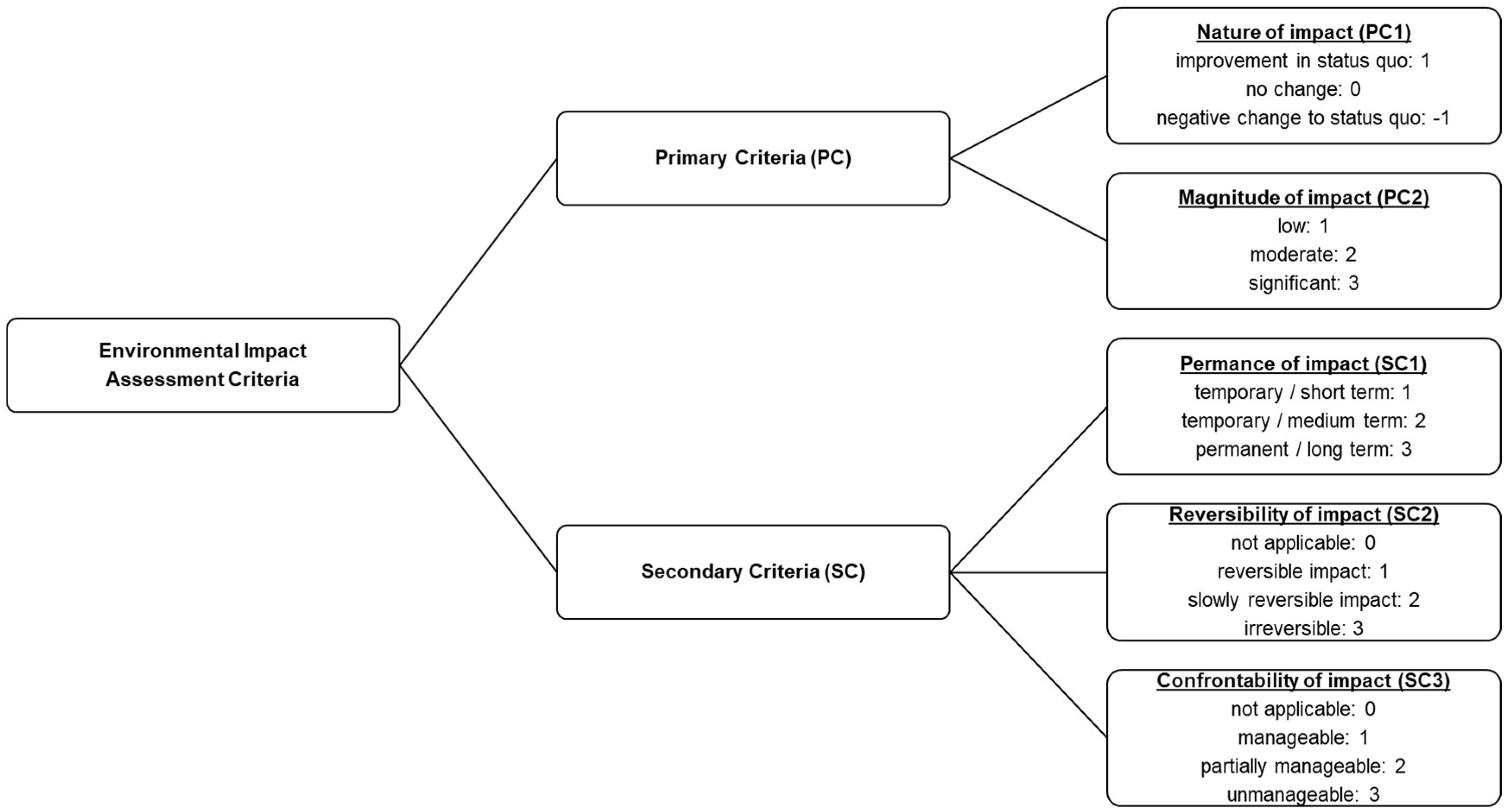
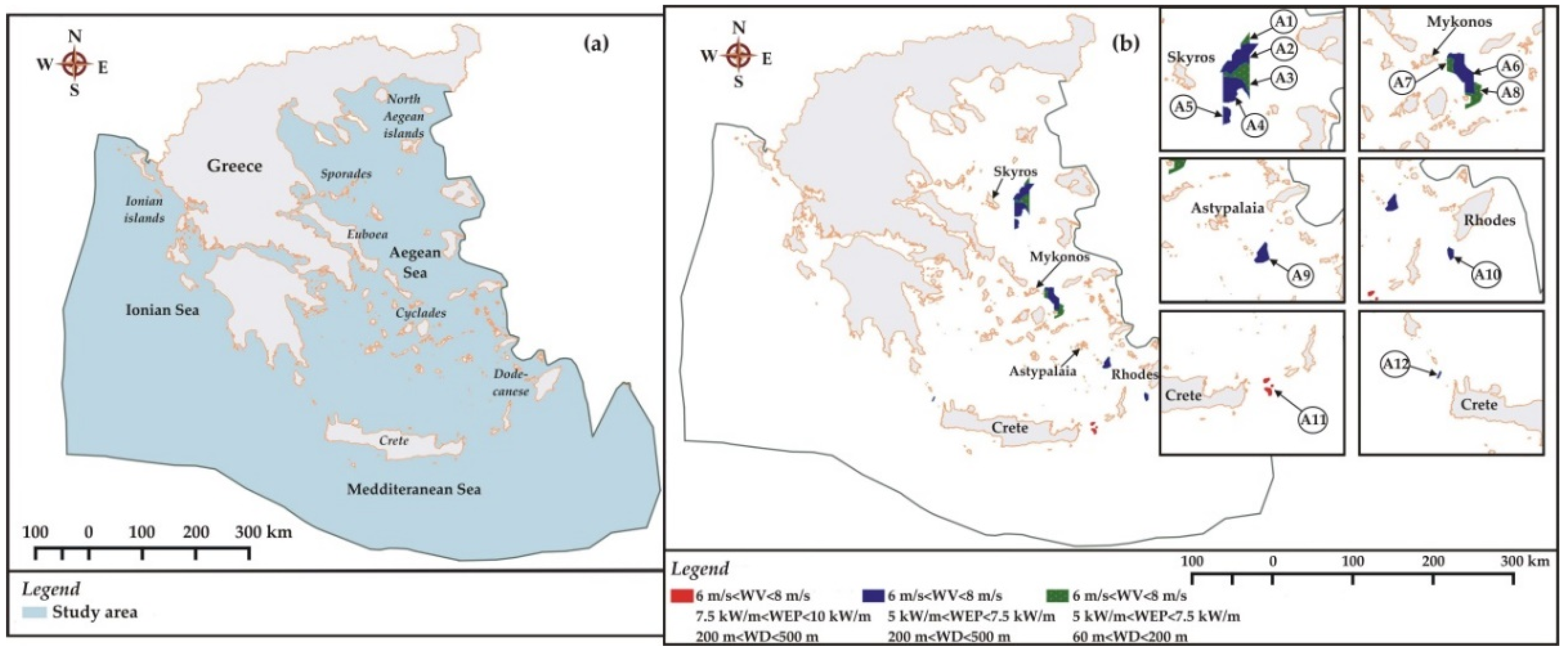
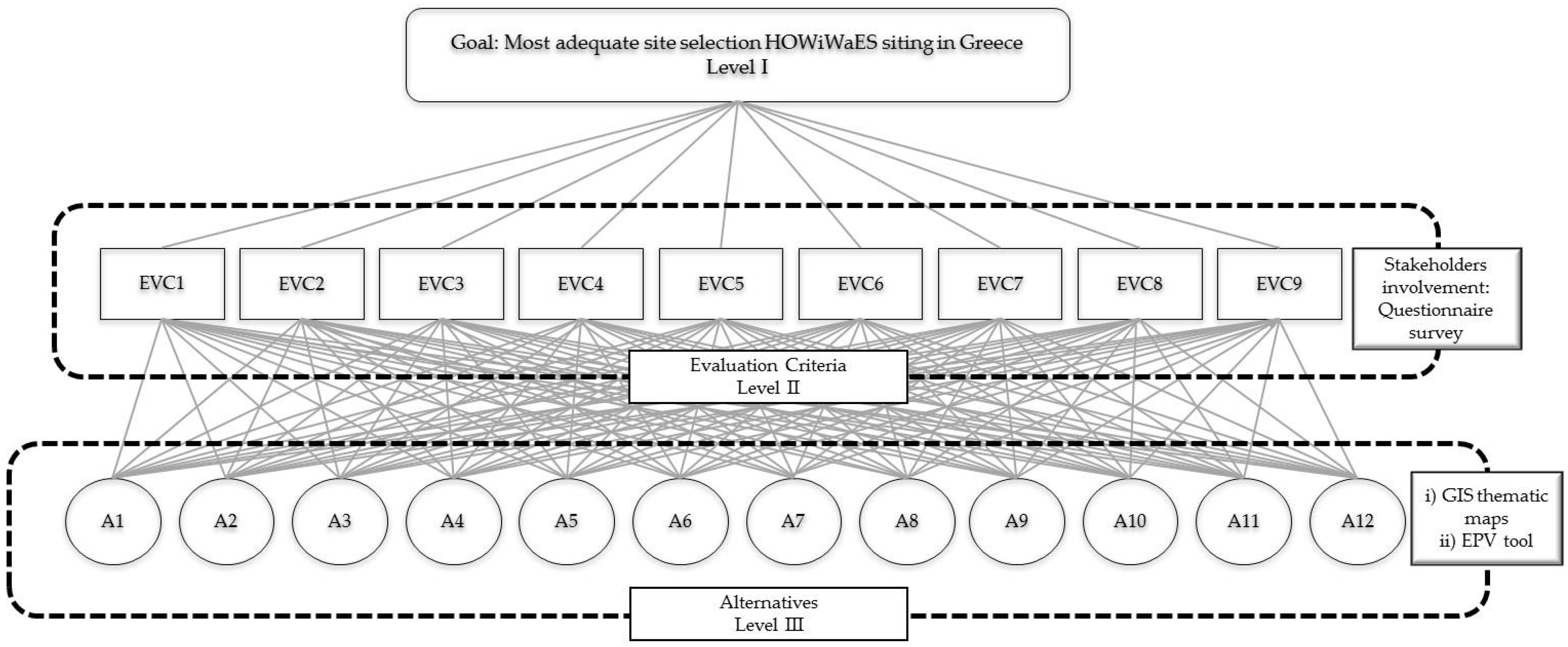
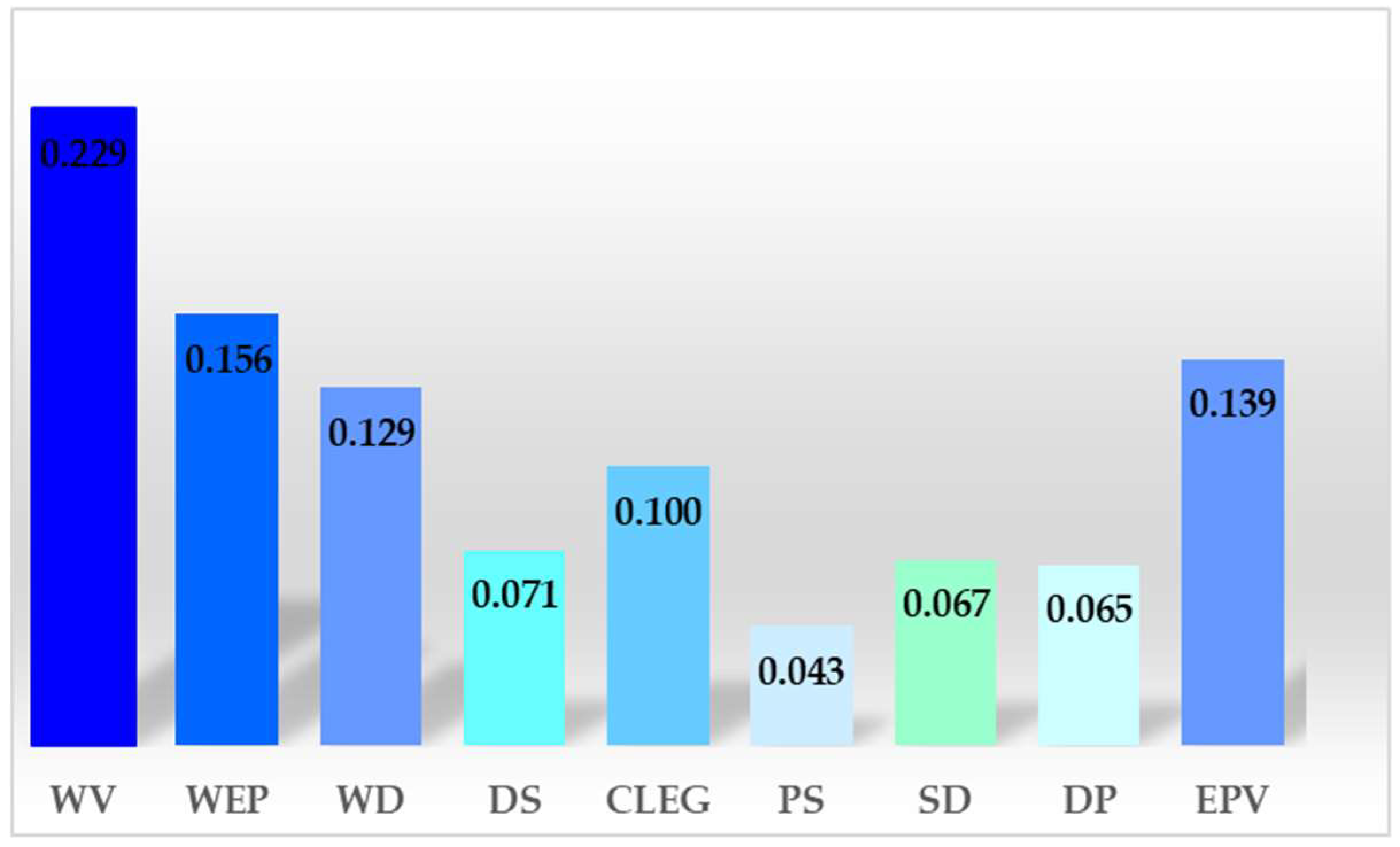
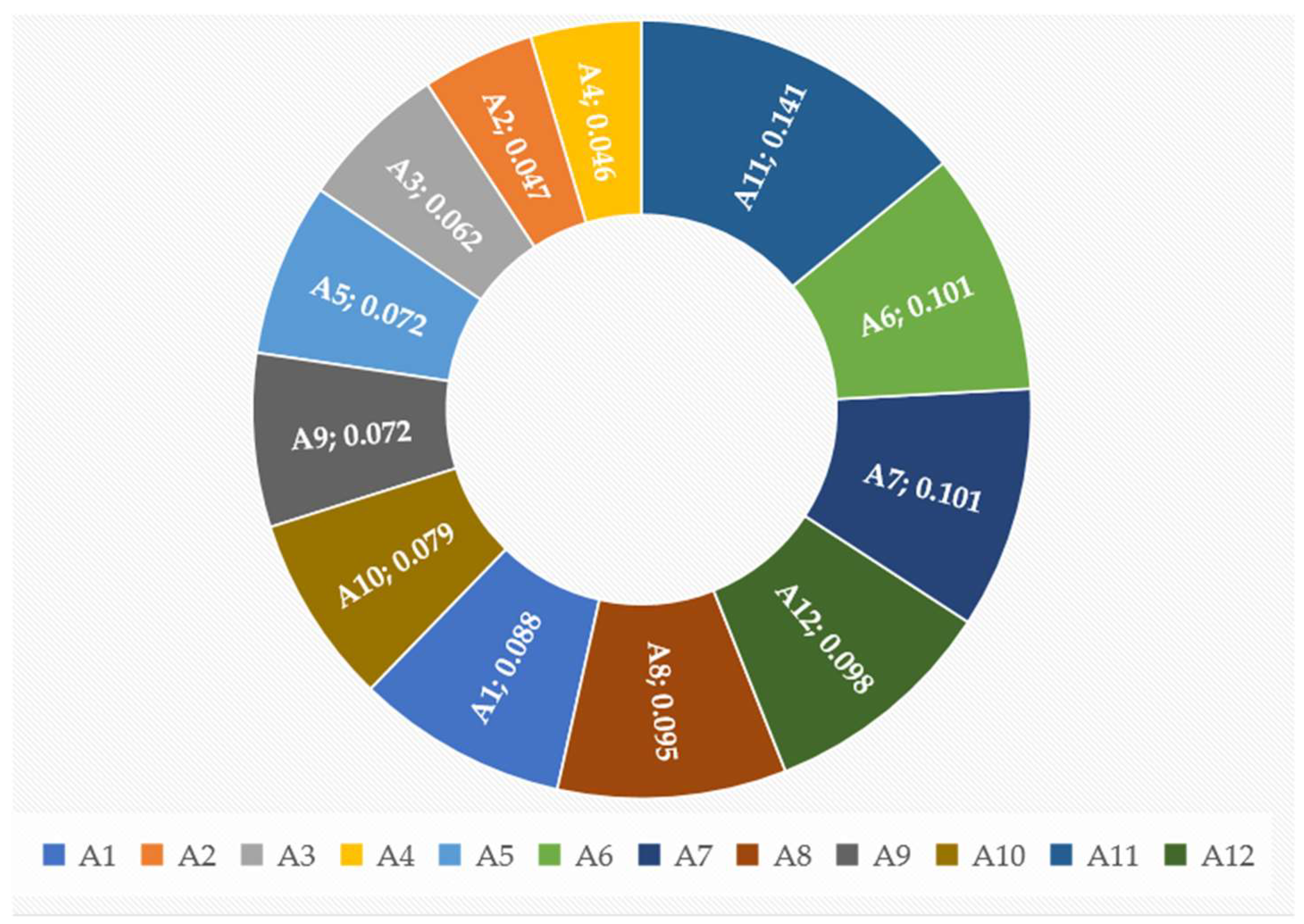
| Impact Range Bands | Description | EPV |
|---|---|---|
| Extremely positive impacts | positive, significant, long term impacts | 54 |
| Significant positive impacts | positive, significant, medium term impacts | 36 |
| Moderate positive impacts | positive, moderate, medium term impacts | 24 |
| Positive impacts | positive, low, long term impacts | 18 |
| Slight positive impacts | positive, low, short term impacts | 6 |
| No change-status quo | no impacts | 0 |
| Slight negative impacts | negative, low, short term, reversible, manageable impacts | −18 |
| Negative impacts | negative, low, long term, reversible, manageable impacts | −30 |
| Moderate negative impacts | negative, moderate, long term, reversible, manageable impacts | −60 |
| Significant negative impacts | negative, moderate, long term, irreversible, unmanageable impacts | −108 |
| Extremely negative impacts | negative, significant, long term, irreversible, unmanageable impacts | −162 |
| Category | WV (m/sec) | WEP (kW/m) | WD (m) | Siting Alternative ID | Area (km2) | Location |
|---|---|---|---|---|---|---|
| Category 1 | 6–8 | 7.5–10 | 200–500 | A11 | 81.32 | East (E) of Crete |
| Category 2 | 6–8 | 5–7.5 | 200–500 | A2 | 467.33 | East-North-East (ENE) of Skyros |
| A4 | 427.7 | South-East (SE) of Skyros | ||||
| A5 | 113.19 | South-South-East (SSE) of Skyros | ||||
| A6 | 516.86 | East-South-East (ESE) of Mykonos | ||||
| A9 | 192.32 | South-East (SE) of Astypalaia | ||||
| A10 | 86.56 | South-West (SW) of Rhodes | ||||
| A12 | 21.12 | North-West (NW) of Crete | ||||
| Category 3 | 6–8 | 5–7.5 | 60–200 | A1 | 45.77 | North-East (NE) of Skyros |
| A3 | 283.27 | East (E) of Skyros | ||||
| A7 | 88.37 | East (E) of Mykonos | ||||
| A8 | 212.48 | South-East (SE) of Mykonos |
| Evaluation Criteria | Description |
|---|---|
| EVC1: Wind Velocity (WV) | Mean WV (10 m above the mean water level) exceeding 6 m/s is considered. Larger WV corresponds to higher preference. |
| EVC2: Wave Energy Potential (WEP) | WEP exceeding 5 KW/m is considered. Larger WEP corresponds to higher preference. |
| EVC3: Water Depth (WD) | WD ranges between 0 m and 500 m are considered. Smaller WD corresponds to higher preference. |
| EVC4: Distance from Shore (DS) | DS ranges between 25 m and 200m are considered. Smaller DS corresponds to higher preference. |
| EVC5: Connection to Local Electrical Grid (CLEG) | The proximity to a local electrical grid with high voltage capacity is assessed. Closer proximity corresponds to higher preference. |
| EVC6: Population Served (PS) | The PS in terms of covering energy demands at a mean distance smaller than 100 km from the centroid of an eligible marine area (where one or more ports exist) is considered. Larger PS corresponds to higher preference. |
| EVC7: Shipping Density (SD) | Qualitative assessment based on the existence of navigation routes and traffic volume (low, moderate, high). Lower SD corresponds to higher preference. |
| EVC8: Distance from Ports (DP) | DP ranges from 50 m to 100 m. Smaller DP corresponds to higher preference. |
| EVC9: Environmental Performance Value (EPV) | EPV defines the HOWiWaES impacts on natural and anthropogenic environment during construction, operational and decommissioning phase. Larger EPV corresponds to higher preference. |
| Decision Alternative | EVC1 | EVC2 | EVC3 | EVC4 | EVC5 | EVC6 | EVC7 | EVC8 |
|---|---|---|---|---|---|---|---|---|
| A1 | 0.063 | 0.071 | 0.150 | 0.026 | 0.035 | 0.018 | 0.104 | 0.014 |
| A2 | 0.063 | 0.071 | 0.050 | 0.041 | 0.035 | 0.021 | 0.022 | 0.029 |
| A3 | 0.063 | 0.071 | 0.150 | 0.030 | 0.035 | 0.012 | 0.022 | 0.016 |
| A4 | 0.063 | 0.071 | 0.050 | 0.065 | 0.035 | 0.012 | 0.022 | 0.018 |
| A5 | 0.063 | 0.071 | 0.050 | 0.034 | 0.035 | 0.045 | 0.022 | 0.029 |
| A6 | 0.188 | 0.071 | 0.050 | 0.113 | 0.092 | 0.077 | 0.104 | 0.164 |
| A7 | 0.063 | 0.071 | 0.150 | 0.127 | 0.092 | 0.120 | 0.104 | 0.188 |
| A8 | 0.063 | 0.071 | 0.150 | 0.144 | 0.092 | 0.083 | 0.104 | 0.248 |
| A9 | 0.063 | 0.071 | 0.050 | 0.024 | 0.044 | 0.041 | 0.240 | 0.120 |
| A10 | 0.063 | 0.071 | 0.050 | 0.139 | 0.092 | 0.198 | 0.047 | 0.045 |
| A11 | 0.188 | 0.214 | 0.050 | 0.133 | 0.219 | 0.071 | 0.104 | 0.055 |
| A12 | 0.063 | 0.071 | 0.050 | 0.124 | 0.194 | 0.301 | 0.104 | 0.072 |
| Environmental Components | Construction Phase | Operational Phase | Decommissioning | Potential Impacts | |
|---|---|---|---|---|---|
| Climate | - | - | - | - | |
| Bioclimate | - | - | - | - | |
| Morphology | - | - | - | - | |
| Aesthetics-visional features | X | X | - | Disruption from tall structures (near shore wind farms) | |
| Geology | - | - | - | - | |
| Tectonics | - | - | - | - | |
| Soils | - | - | - | - | |
| Natural environ-ment | Seabirds | X | X | - | Disturbance and emigration, collision fatalities |
| Fish/ marine mammals | X | X | X | Displacement or loss of habitat due to noise, electromagnetic emissions and vibrations | |
| Land uses | - | - | - | - | |
| Built environment | - | - | - | - | |
| Historical and cultural environment | - | - | - | - | |
| Socio-economic environment | X | X | X | Minor restriction of shipping routes, minor impacts on tourism activities | |
| Infrastructures | - | - | - | - | |
| Atmospheric environment | X | X | X | Low air pollutant emissions (construction, maintenance, disposal) | |
| Acoustic environment-noise | - | X | - | Increased underwater sound levels | |
| Vibrations | - | X | - | Increased vibrations | |
| Electromagnetic fields | - | X | - | Emission of electromagnetic fields | |
| Surface waters and groundwater | X | X | X | alteration of flows, Pollution from increased vessel traffic, sediment redistribution | |
| Decision Alternative | Α1 | A2 | A3 | A4 | Α5 | A6 | A7 | A8 | A9 | Α10 | Α11 | Α12 | Relative Weights |
|---|---|---|---|---|---|---|---|---|---|---|---|---|---|
| Α1 | 1 | 6 | 4 | 7 | 1 | 9 | 3 | 6 | 4 | 3 | 3 | 3 | 0.207 |
| A2 | 1/6 | 1 | 1/3 | 2 | 1/6 | 4 | 1/4 | 1 | 1/3 | 1/4 | 1/4 | 1/4 | 0.029 |
| A3 | 1/4 | 3 | 1 | 4 | 1/4 | 6 | 1/2 | 3 | 1 | 1/2 | 1/2 | 1/2 | 0.060 |
| A4 | 1/7 | 1/2 | 1/4 | 1 | 1/7 | 3 | 1/5 | 1/2 | 1/4 | 1/5 | 1/5 | 1/5 | 0.021 |
| Α5 | 1 | 6 | 4 | 7 | 1 | 9 | 3 | 6 | 4 | 3 | 3 | 3 | 0.207 |
| A6 | 1/9 | 1/4 | 1/6 | 1/3 | 1/9 | 1 | 1/7 | 1/4 | 1/6 | 1/7 | 1/7 | 1/7 | 0.013 |
| A7 | 1/3 | 4 | 2 | 5 | 1/3 | 7 | 1 | 4 | 2 | 1 | 1 | 1 | 0.093 |
| A8 | 1/6 | 1 | 1/3 | 2 | 1/6 | 4 | 1/4 | 1 | 1/3 | 1/4 | 1/4 | 1/4 | 0.029 |
| A9 | 1/4 | 3 | 1 | 4 | 1/4 | 6 | 1/2 | 3 | 1 | 1/2 | 1/2 | 1/2 | 0.060 |
| Α10 | 1/3 | 4 | 2 | 5 | 1/3 | 7 | 1 | 4 | 2 | 1 | 1 | 1 | 0.093 |
| Α11 | 1/3 | 4 | 2 | 5 | 1/3 | 7 | 1 | 4 | 2 | 1 | 1 | 1 | 0.093 |
| Α12 | 1/3 | 4 | 2 | 5 | 1/3 | 7 | 1 | 4 | 2 | 1 | 1 | 1 | 0.093 |
© 2018 by the authors. Licensee MDPI, Basel, Switzerland. This article is an open access article distributed under the terms and conditions of the Creative Commons Attribution (CC BY) license (http://creativecommons.org/licenses/by/4.0/).
Share and Cite
Loukogeorgaki, E.; Vagiona, D.G.; Vasileiou, M. Site Selection of Hybrid Offshore Wind and Wave Energy Systems in Greece Incorporating Environmental Impact Assessment. Energies 2018, 11, 2095. https://doi.org/10.3390/en11082095
Loukogeorgaki E, Vagiona DG, Vasileiou M. Site Selection of Hybrid Offshore Wind and Wave Energy Systems in Greece Incorporating Environmental Impact Assessment. Energies. 2018; 11(8):2095. https://doi.org/10.3390/en11082095
Chicago/Turabian StyleLoukogeorgaki, Eva, Dimitra G. Vagiona, and Margarita Vasileiou. 2018. "Site Selection of Hybrid Offshore Wind and Wave Energy Systems in Greece Incorporating Environmental Impact Assessment" Energies 11, no. 8: 2095. https://doi.org/10.3390/en11082095
APA StyleLoukogeorgaki, E., Vagiona, D. G., & Vasileiou, M. (2018). Site Selection of Hybrid Offshore Wind and Wave Energy Systems in Greece Incorporating Environmental Impact Assessment. Energies, 11(8), 2095. https://doi.org/10.3390/en11082095







